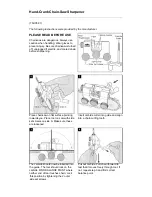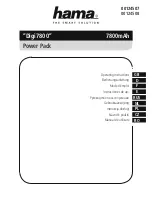
7
7
parts. Follow instructions in the Maintenance section of
this manual. Use of unauthorized parts or failure to follow
Maintenance instructions may create a risk of shock or
injury.
SPECIFIC SAFETy RUlES
■ Hold tool by insulated gripping surfaces when performing
an operation where the cutting tool may contact hidden
wiring. Contact with a “live” wire will also make exposed
metal parts of the tool “live” and shock the operator.
■ Know your power tool. Read operator’s manual carefully.
Learn its applications and limitations, as well as the specific
potential hazards related to this tool. Following this rule will
reduce the risk of electric shock, fire, or serious injury.
■ Eye protection which conforms to ANSI specifications
and provides protection against flying particles both
from the FRONT and SIDE should ALWAYS be worn by
the operator and others in the work area when loading,
operating or servicing this tool. Eye protection is required
to guard against flying fasteners and debris, which could
cause severe eye injury.
■ The employer and/or user must ensure that proper eye
protection is worn. We recommend Wide Vision Safety
Mask for use over eyeglasses or standard safety glasses
that provide protection against flying particles both from the
front and side. Always use eye protection which is marked
to comply with ANSI Z87.1.
■ Additional safety protection will be required in some
environments. For example, the working area may include
exposure to noise level which can lead to hearing damage.
The employer and user must ensure that any necessary
hearing protection is provided and used by the operator and
others in the work area. Some environments will require
the use of head protection equipment. When required,
the employer and user must ensure that head protection
conforming to ANSI Z89.1-1997 is used.
■ Protect your lungs. Wear a face or dust mask if the
operation is dusty. Following this rule will reduce the risk of
serious personal injury.
■ Protect your hearing. Wear hearing protection during
extended periods of operation. Following this rule will
reduce the risk of serious personal injury.
■ Battery tools do not have to be plugged into an electrical
outlet; therefore, they are always in operating condition. Be
aware of possible hazards when not using your battery tool
or when changing accessories.
■ Following this rule will reduce the risk of electric shock, fire,
or serious personal injury.
■ Do not place battery tools or their batteries near fire or heat.
This will reduce the risk of explosion and possibly injury.
■ Do not crush, drop or damage battery pack. Do not use a
battery pack or charger that has been dropped or received
a sharp blow. A damaged battery is subject to explosion.
Properly dispose of a dropped or damaged battery
immediately.
■ Batteries can explode in the presence of a source of ignition,
such as a pilot light. To reduce the risk of serious personal
injury, never use any cordless product in the presence of
open flame. An exploded battery can propel debris and
chemicals. If exposed, flush with water immediately.
■ Do not charge battery tool in a damp or wet location.
Following this rule will reduce the risk of electric shock.
■ For best results, your battery tool should be charged in a
location where the temperature is more than 50°F but less
than 100°F. Do not store outside or in vehicles.
■ Under extreme usage or temperature conditions, battery
leakage may occur. If liquid comes in contact with your skin,
wash immediately with soap and water, then neutralize with
lemon juice or vinegar. If liquid gets into your eyes, flush
them with clean water for at least 10 minutes, then seek
immediate medical attention. Following this rule will reduce
the risk of serious personal injury.
■ Use the tool only for its intended use. Do not discharge
fasteners into open air.
■ Keep hands and body parts clear of immediate work
area. Hold workpiece with clamps when necessary to
keep hands and body out of potential harm. Be sure the
workpiece is properly secured before pressing the nailer
against the material. The workpiece contact may cause the
work material to shift unexpectedly.
■ Keep face and body parts away from back of the tool cap
when working in restricted areas. Sudden recoil can result
in impact to the body, especially when nailing into hard or
dense material.
■ Never use this tool in a manner that could cause a fastener
to be directed toward anything other than the workpiece.
■ Do not use the tool as a hammer.
■ Always carry the tool by the handle. Never carry the tool
by the air hose.
■ Do not alter or modify this tool from the original design or
function without approval from the manufacturer.
■ Always be aware that misuse and improper handling of
this tool can cause injury to yourself and others.
■ Never clamp or tape the trigger or workpiece contact in an
actuated position.
■ Never leave a tool unattended with the battery installed.
■ Do not operate this tool if it does not contain a legible
warning label.
■ Do not continue to use a tool that does not function
properly.
OPERATION
■ Do not use tool if trigger does not actuate properly. Any tool
that cannot be controlled with the trigger is dangerous and
must be repaired.
■ Check operation of the workpiece contact mechanism
frequently. Do not use the tool if the workpiece contact
mechanism is not working correctly as accidental driving
of a fastener may result. Do not interfere with the proper
operation of the workpiece contact mechanism.
■ Use only fasteners that are recommended for your model.
■ Always assume that the tool contains fasteners.
■ Do not carry the tool from place to place holding the trigger.
Accidental discharge could result.
■ Always handle the tool with care:
● Respect the tool as a working implement.
● Never engage in horseplay.
● Never pull the trigger unless nose is directed toward
the work.
● Keep others a safe distance from the tool while tool is in
Содержание AFNDA18
Страница 1: ...AFNDA18 Original Instructions ...
Страница 2: ...2 2 ...
Страница 11: ...11 11 ...
Страница 12: ...AEG Electric Tools Max Eyth Straße 10 D 71364 Winnenden Germany ...






























